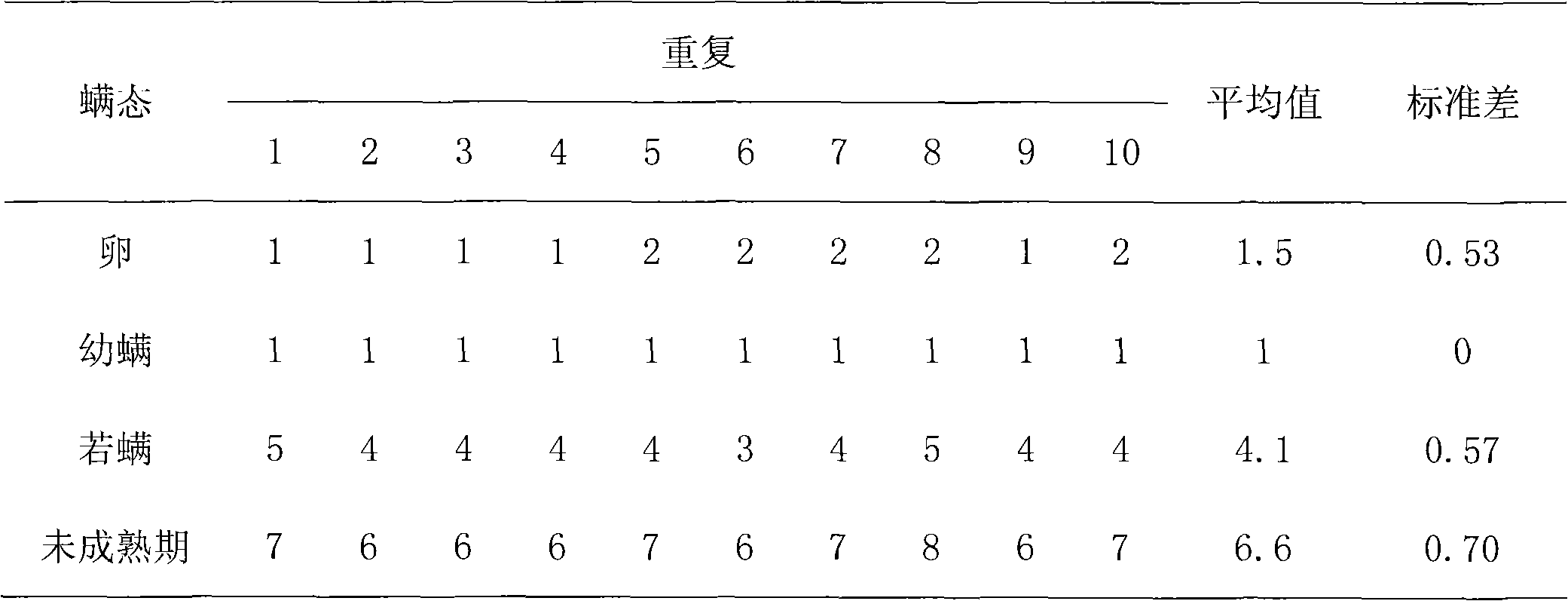Novel method for artificial mass rearing of Amblyseius orientalis
A technique of Amblyseius, a new method, applied in the field of biological control of agricultural pests, can solve the problems of complex operation and high cost, and achieve the effect of high-efficiency mass breeding
- Summary
- Abstract
- Description
- Claims
- Application Information
AI Technical Summary
Problems solved by technology
Method used
Image
Examples
Embodiment 1
[0037] The preferred method of embodiment 1 artificially rearing Amblyseius orientalis in large quantities
[0038] Under the conditions of 20-30°C and relative humidity of 70%-90%, use sweet fruit mite alone as feeding prey to artificially raise a large number of A. orientalis. A. orientalis and A. orientalis with feeding medium and A. orientalis with feeding material were added in the feeding container containing feeding medium at a ratio of 50:1 between A. orientalis and A. orientalis. A. orientalis The amount of mite initially inserted into the feed was 1 head / g. During the feeding process, sweet fruit mite and its feed were added once every 10 days. The feeding period was 30 days. The population density of Amblyseius orientalis in the feed It can be ≥20 heads / g. At this time, Amblyseius orientalis can be packaged as a finished product, multiplied and raised or stored at low temperature. It can be packaged in paper bags or plastic bottles. Among them:
[0039] The feeding...
Embodiment 2
[0041] Embodiment 2 utilizes sweet fruit mite, the method for raising Amblyseius orientalis with water tray method
[0042] In a fresh-keeping box with a height of 10 cm, a width of 10 cm, and a length of 10 cm, put a sponge with a length, width, and height of 8 cm, 8 cm, and 5 cm respectively, and then add water to the fresh-keeping box. 4 cm, and then put a round filter paper on the sponge, the filter paper is completely on the sponge, and then put a round black plastic film paper in the center of the filter paper, the black plastic film paper is slightly smaller than the filter paper. Insert 10 female adults of Amblyseius orientalis and 100-200 heads of sweet fruit mite on the black plastic film paper, then put 1-2 pieces of raw food, and put the fresh-keeping box in a room with a temperature of 27°C and a relative humidity of 75%. Under the same conditions, add raw mother-eating tablets and sweet fruit mite once every 7 days, and pay attention to adding isolated water in t...
Embodiment 3
[0043] Example 3 A preferred method for artificially raising Amblyseius orientalis in large quantities using the composition of sweet fruit mite and other foods
[0044] Under the conditions of 16-35°C and relative humidity of 60%-95%, first raise and prepare sweet fruit mite and prepare other prey, and then press the 50:1 ratio of sweet fruit mite and amblyseius orientalis in a rearing container containing feeding medium. The proportion of A. orientalis with feeding medium and sweet fruit mite with feeding material was added. The initial amount of A. orientalis feeding was 1 head / g, and sweetener was added every 10 days during the feeding process. Fruit mites and their feed, the feeding period is 30 days, in which A. orientalis is fed for 15 days with sweet fruit mites, and then the other prey mentioned are put into the container, and the amount of A. orientalis in the feed is ≥ 10 heads The finished product can be packaged per gram, multiplied and raised or stored at low tem...
PUM
 Login to View More
Login to View More Abstract
Description
Claims
Application Information
 Login to View More
Login to View More - R&D
- Intellectual Property
- Life Sciences
- Materials
- Tech Scout
- Unparalleled Data Quality
- Higher Quality Content
- 60% Fewer Hallucinations
Browse by: Latest US Patents, China's latest patents, Technical Efficacy Thesaurus, Application Domain, Technology Topic, Popular Technical Reports.
© 2025 PatSnap. All rights reserved.Legal|Privacy policy|Modern Slavery Act Transparency Statement|Sitemap|About US| Contact US: help@patsnap.com



